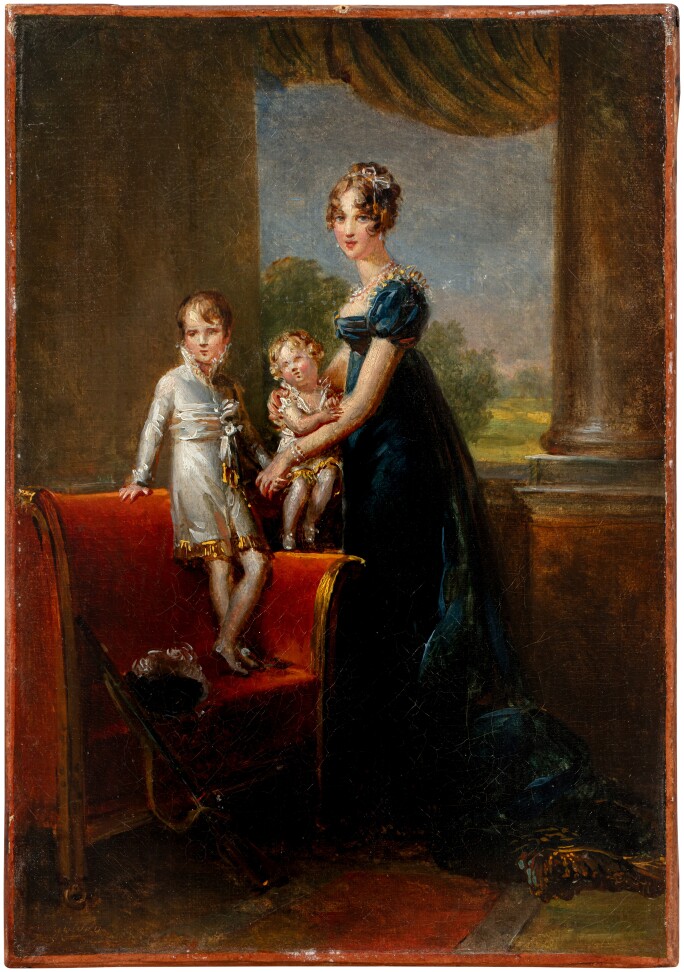Hortense de Beauharnais (1783-1837)

The daughter of Joséphine and her first husband Alexandre de Beauharnais, Hortense spent her childhood in Paris and then at Madame Campan's boarding house in Saint-Germain-en-Laye. Very close to her mother, she was also adopted by Napoleon after his marriage to Joséphine in 1796. To strengthen her ties with the Bonaparte family, Joséphine decided to have Hortense marry Louis Bonaparte, one of Napoleon's younger brothers, in 1802. Hortense was therefore both the First Consul's daughter-in-law and sister-in-law. Despite their notorious disagreement, the couple had three sons, including Charles-Louis (1808-1873), the future Napoleon III.
The Emperor had no descendants with Joséphine, and wished to have an heir with Bonaparte and Beauharnais blood, so he made the children of Hortense and Louis the heirs presumptive to the crown.
She became queen of Holland when Napoleon placed her brother on the throne in 1806, and remained there until 1810, when she returned to Paris to follow the imperial court, despite her mother's divorce from the Emperor. She even managed to make friends with the new Empress Marie-Louise. When the Empire fell, Hortense placed herself under the protection of Tsar Alexander I, but remained loyal to Napoleon during the Hundred Days. She was forced into exile in Switzerland, where in 1817 she bought the Château d'Arenberg and brought up her children there. She then went to Bavaria and Rome before returning to Paris for a while, then to England, and finally back to Switzerland, where she lived until her death in 1837.
Martin-Guillaume Biennais (1764-1843)
Tablemaker under the Ancien Régime, he took advantage of the end of the guilds, abolished during the Revolution, to diversify his business and become a goldsmith in particular. He met General Bonaparte and made travel kits for him. A loyal customer, Bonaparte, who had become consul, entrusted him with exclusive rights to make tableware, a title he retained under the Empire, with the exception of the large vermeil set made by Henry Auguste and donated by the city of Paris in 1804. Biennais made numerous services for Napoleon I, as well as for the rest of the royal family, including Joséphine, Hortense and Louis and Jérôme Bonaparte. At the height of his fame, he employed more than eighty workers in his workshop on the rue Honoré. To make Hortense's service, he subcontracted some of the work to Lorillon, as we can see from some of the service's cutlery.
Hortense de Beauharnais (1783-1837)

Fille de Joséphine et son premier mari Alexandre de Beauharnais, Hortense passe son enfance à Paris puis dans la pension de Madame Campan à Saint-Germain-en-Laye. Très proche de sa mère, elle est également adoptée par Napoléon après son mariage avec Joséphine en 1796. Afin de resserrer les liens avec la famille Bonaparte, Joséphine décide de marier Hortense à Louis Bonaparte, l’un des frères cadets de Napoléon, en 1802. Hortense est donc à la fois la belle-fille et la belle-sœur du Premier Consul. Le couple, malgré sa mésentente notoire, a trois fils dont Charles-Louis (1808-1873) futur Napoléon III.
L’Empereur sans descendance avec Joséphine, et souhaitant avoir un héritier avec du sang Bonaparte et Beauharnais, fait des enfants d’Hortense et de Louis les héritiers présomptifs de la couronne.
Elle devient reine de Hollande lorsque Napoléon met son frère sur le trône en 1806 jusqu’en 1810 et retourne à Paris pour suivre la cour impériale, malgré le divorce de sa mère avec l’Empereur. Elle parvient même à devenir amie avec la nouvelle Impératrice Marie-Louise. Lors de la chute de l’Empire, Hortense se place sous la protection du tsar Alexandre Ier mais reste fidèle à Napoléon pendant les Cent Jours. Elle est contrainte à l’exil en Suisse où elle achète en 1817 le château d’Arenberg et y élève ses enfants. Elle part ensuite en Bavière, à Rome, avant de revenir à Paris quelque temps puis en Angleterre et enfin de revenir en Suisse où elle réside jusqu’à sa mort en 1837.
Martin-Guillaume Biennais (1764-1843)
Tabletier sous l'Ancien Régime, il profite de la fin des corporations, supprimées pendant la Révolution, pour diversifier son activité et devenir notamment orfèvre. Il rencontre le général Bonaparte et réalise des nécessaires de voyage pour lui. Fidèle client, Bonaparte, devenu consul lui confie l'exclusivité des fournitures de la table, titre qu'il conserve sous l'Empire, à l'exception du grand vermeil offert par la ville de Paris en 1804 réalisé par Henry Auguste. Biennais réalise de nombreux services pour Napoléon Ier, mais également pour le reste de la famille royale comme Joséphine, Hortense mais aussi Louis et Jérôme Bonaparte. Au fait de sa gloire, il emploie plus de quatre-vingts ouvriers dans son atelier rue Honoré. Pour réaliser le service d’Hortense, il sous-traite une partie des pièces à Lorillon, comme nous pouvons le voir pour certains couverts du service.